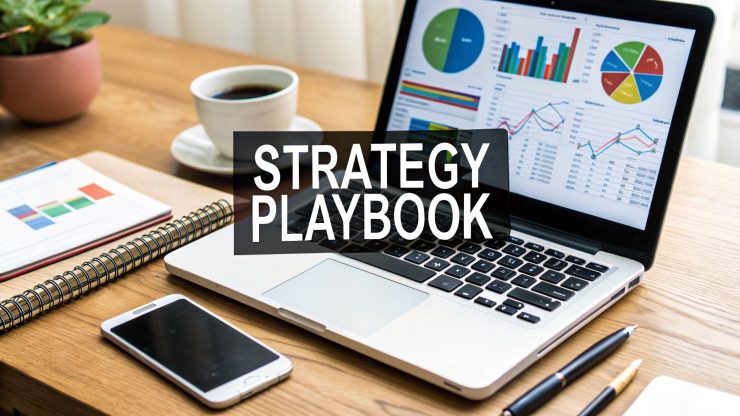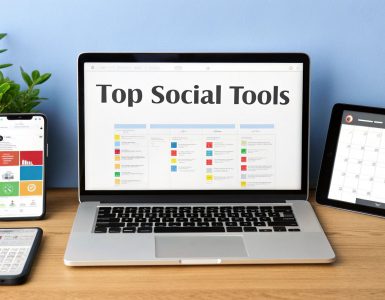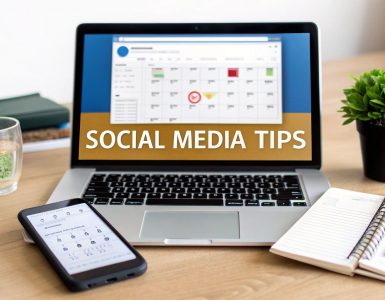Having a real social media content strategy isn't just about having a plan; it's about being intentional. It's what separates brands that see real growth from those who just post for the sake of posting. This is how you stop treating social media as a daily chore and start turning it into an engine that predictably drives your business forward.
Why a Social Media Content Strategy Matters

Does your social media feel like you're just shouting into the void? It's a common frustration. So many businesses pour time and energy into posts that get crickets for engagement, leaving them wondering if there's any real return on their investment (ROI). Without a documented plan, it’s easy to fall into a reactive cycle instead of building a proactive asset for your brand.
A solid strategy brings much-needed consistency to your brand's message. This is just as critical online as it is when you’re developing a strong brand strategy for your physical marketing materials. That consistency is what builds brand recognition and, more importantly, the trust that convinces consumers to buy.
The Real Cost of Neglecting Your Strategy
Let's be blunt: posting without a plan isn't just inefficient—it's expensive. It costs you time, money, and countless opportunities to actually connect with the people you want to reach. Businesses that "wing it" almost always run into the same roadblocks.
These challenges usually boil down to:
- Wasted Resources: Countless hours spent creating content that doesn't resonate with your audience or move the needle on business goals.
- Inconsistent Brand Voice: Confusing your followers with mixed messaging, which dilutes your brand identity and makes you forgettable.
- Missed Opportunities: Failing to jump on relevant trends or conversations in a timely manner, letting your competitors get all the attention.
- Poor ROI: Being completely unable to measure what’s working, making it impossible to justify the time and budget you're spending.
A well-crafted plan takes the guesswork out of content creation. It gives you a clear roadmap, transforming your social media presence from a random collection of posts into a powerful tool for growth.
Turning Social Feeds into Business Assets
The digital stage has never been more crowded, but it’s also never been more important for businesses. The numbers are staggering. By 2025, there will be roughly 5.45 billion social media users worldwide. The average person spends nearly two and a half hours a day scrolling through about seven different platforms.
Even more crucial for businesses, over 25% of those users are actively looking for products to buy on social media. It has become a vital stop on the customer journey.
This guide is designed to give you a step-by-step process for building a strategy that actually delivers. We’ll walk through everything from setting meaningful goals and identifying content pillars to automating your workflow. By the end, you'll have a framework for a social media content strategy that's both sustainable and effective.
To give you a clearer picture of what we're building, here’s a quick overview of the core components of a successful social media strategy. Each pillar works together to create a cohesive and powerful plan.
Core Pillars of a Successful Social Media Strategy
| Pillar | Core Objective | Key Benefit |
|---|---|---|
| Clear Objectives | Define specific, measurable goals that align directly with your business needs. | Ensures every social media activity has a clear purpose and contributes to growth. |
| Audience Insight | Deeply understand your target audience's needs, pain points, and online habits. | Allows you to create highly relevant content that genuinely resonates and engages. |
| Content Buckets | Organize your content into key themes or categories that support your goals. | Prevents repetitive posting and guarantees a balanced, interesting content mix. |
| Evergreen Scheduling | Systematically repurpose and reshare your best-performing, timeless content. | Maximizes the value of your content, saves time, and drives consistent traffic. |
| Smart Automation | Use tools to streamline posting, freeing up time for engagement and analysis. | Increases efficiency, maintains a consistent presence, and reduces manual workload. |
Think of these pillars as the foundation. With a strong base in place, you can build a social media presence that not only captures attention but also drives meaningful results for your business.
Setting Goals That Actually Grow Your Business
Let's be honest. If your social media goal is just to "get more likes," you're leaving money on the table. A truly effective social media content strategy doesn't just make noise; it connects every single post, story, and video directly to tangible business outcomes.
Fuzzy goals get you fuzzy results. So instead of aiming for something vague like "better engagement," let's tie your strategy to goals that actually move the needle. This means ditching the vanity metrics for KPIs that translate into real revenue, customer loyalty, and industry authority.
Putting the SMART Framework to Work
The secret is making your objectives specific, measurable, achievable, relevant, and time-bound—what's known as the SMART framework. This isn't just some textbook acronym; it’s a practical tool that forces you to get crystal clear on what success actually looks like.
Let’s see how this plays out in the real world:
-
You're a SaaS Company: Instead of "increase brand awareness," a much smarter goal is: "Generate 150 qualified leads for our new feature through LinkedIn content in Q3." It’s specific (qualified leads), measurable (150), and time-bound (Q3), directly supporting your need for user acquisition.
-
You're an E-commerce Brand: Don't just say "boost sales." Get precise: "Increase the repeat purchase rate from existing customers by 15% over the next six months using targeted Instagram and Facebook campaigns." Now you’re focused on customer loyalty and lifetime value—far more profitable than chasing one-off sales.
See the difference? These examples shift your focus from simply being active on social media to achieving a meaningful business impact. Each goal immediately tells you what kind of content to create, who to target, and how you’ll know if you're winning.
Moving from Vanity Metrics to Actionable KPIs
Once you have a solid SMART goal, you need the right Key Performance Indicators (KPIs) to track your progress. Too many marketers fall into the trap of chasing vanity metrics—numbers that look impressive on a report but don’t reflect the health of the business.
A thousand likes on a post mean absolutely nothing if none of those people ever visit your website or consider buying from you. The goal isn't to be popular; it's to be profitable.
To avoid this trap, make sure your KPIs are directly tied to your specific business objective. Here’s a simple way to think about it:
| Business Goal | Vanity Metric to Avoid | Actionable KPI to Track |
|---|---|---|
| Generate Qualified Leads | Follower Count | Conversion Rate on landing pages from social traffic, Cost Per Lead (CPL) |
| Boost Customer Loyalty | Post Likes | Customer Lifetime Value (CLV) from social cohorts, Repeat Purchase Rate |
| Establish Industry Authority | Reach / Impressions | Share of Voice (your brand's mentions vs. competitors), Website Referrals from thought leadership |
Let's go back to that SaaS company aiming for 150 leads. Their primary KPIs aren't their LinkedIn follower growth or the number of likes they get.
They should be obsessing over these numbers instead:
- Click-Through Rate (CTR): Are people actually clicking the links in your posts to check out your lead magnet or demo page?
- Landing Page Conversion Rate: Of the people who click, how many are actually filling out the form? A low rate here signals a disconnect between your post's promise and what your landing page delivers.
- Cost Per Lead (CPL): How much are you spending—in time, ad dollars, or both—to get each of those 150 leads? This tells you if the channel is actually sustainable for growth.
This laser-like focus is what turns your social media from a daily chore into a predictable growth engine. When you set goals that directly impact your bottom line and pick KPIs that accurately measure that impact, you build a social media content strategy that's designed to win. Every piece of content suddenly has a job to do.
Stop Guessing, Start Strategizing: How to Build Your Content Pillars
Ever feel like you’re on a content hamster wheel, scrambling for something new to post every single day? If your social media feels more chaotic than cohesive, you’re probably posting at random. It’s time to get strategic and build a solid foundation with content pillars.
Think of content pillars as the main highways of your content strategy. They’re the core themes—the big-picture topics—that your brand will own. Everything you post should branch off from one of these highways. This framework is what separates a forgettable feed from one that consistently delivers value, builds authority, and, frankly, makes your life a whole lot easier.
When you have defined pillars, every post has a purpose. Your feed stops being a collection of random thoughts and transforms into a go-to resource for your ideal audience.
So, What Should My Pillars Be?
Great question. While the exact topics will be unique to your brand, most powerful content strategies lean on a mix of pillar types. The idea is to create a well-rounded experience for your followers that educates, connects, and occasionally sells, keeping them engaged for the long haul.
Here are four foundational pillar types I see work time and time again:
- Teach & Inform (Educational): This is your bread and butter for establishing authority. What can you teach your audience that solves a real problem for them? Think checklists, how-to guides, myth-busting carousels, or simplifying complex industry jargon. You become the expert they trust.
- Pull Back the Curtain (Behind-the-Scenes): Let’s be real—people connect with people, not faceless logos. This pillar is all about showing the human side of your brand. Share stories about your team, give a sneak peek into how your products are made, or even share a candid moment from a team meeting. It builds trust and relatability.
- Celebrate Your People (Community & UGC): Your community is your biggest asset, so put them in the spotlight. Highlighting customer stories, sharing user-generated content (UGC), or running interactive polls and Q&As makes your audience feel seen and valued. It turns followers into advocates.
- Show Your Solution (Promotional): You're in business, after all. Promotional content is where you talk about your products and services, but the key is to frame it around value. Instead of just listing features, show how you solve a specific pain point or help customers achieve a goal.
A good mix of these pillars creates a predictable, yet engaging, rhythm. Your audience learns that they can count on you for helpful tips, a glimpse of your company culture, a sense of community, and clear information on how you can help them.
From Theory to a Real-World Content Plan
Let's ground this in reality. Imagine you're a B2B tech company selling project management software. A random, "post-and-pray" approach might look like sharing company news one day and a generic motivational quote the next. A pillar-based strategy is far smarter.
Here’s how that same company could map their content:
| Content Pillar | Specific Post Idea Example | Platform Idea |
|---|---|---|
| Teach & Inform | A LinkedIn carousel breaking down "5 Project Management Bottlenecks You Can Fix This Week." | |
| Behind-the-Scenes | An Instagram Story showing the dev team celebrating a new feature launch with pizza. | |
| Community (UGC) | A tweet that quotes a glowing review from a customer, tagging their company profile. | Twitter/X |
| Show Your Solution | A short, punchy video on Facebook demonstrating how one software feature saves teams 10+ hours a week. |
See the difference? This structured approach not only ensures a diverse and valuable content mix but also kills the dreaded "what should I post today?" question. Instead, you can ask, "What's a great 'Teach & Inform' post I can create this week?"
Getting this right is more critical than ever. With marketers projected to spend a staggering $276.7 billion on social media ads in 2025, the competition for attention is fierce. In fact, 93% of marketers plan to pour even more resources into social media. To stand out, you can’t just be loud; you have to be strategic. Building your plan on solid content pillars is the first, most important step toward creating content that truly connects. If you want to dig deeper, you can discover more about the 2025 social media trends that will shape the year ahead.
Building an Evergreen Content System That Actually Works
Let's be honest: the constant pressure to churn out new social media content is exhausting. If you’re a social media manager, you know the feeling. The most effective social media content strategy isn’t about what you post today. It’s about building a smart system that keeps working for you long-term. This is where evergreen content becomes your secret weapon.
Imagine having a hand-picked library of your best, most timeless content, ready to go whenever you need it. This isn't about spamming your followers with the same old posts. It’s about being strategic—creating and repurposing high-value assets that stay relevant for months, or even years.
Your Best Content Is Hiding in Plain Sight
You're probably sitting on a goldmine of potential evergreen content and don't even realize it. Take a look at your existing assets—blog posts, case studies, webinars, even glowing customer testimonials. Stop seeing them as one-and-done pieces. Instead, think of them as raw material you can spin into a month's worth of social media posts.
This simple shift changes the game from constant "content creation" to smart "content transformation." One solid, well-researched blog post can be broken down into an entire arsenal of social-friendly content.
- Key Statistics: Pull out those jaw-dropping numbers and create bold, shareable graphics.
- Actionable Tips: Turn a "how-to" section into an easy-to-digest carousel post or a quick video tip.
- Expert Quotes: Lift insightful quotes from your article and feature them as standalone quote cards. They’re perfect for sparking conversation.
By focusing on repurposing, you squeeze every drop of value out of the content you’ve already invested in. This is the core of working smarter, not harder, on social media.
This is often a creative process, not just a box-ticking exercise. Getting the team together to brainstorm how one core idea can be spun into multiple formats can be incredibly effective, as this visual shows.
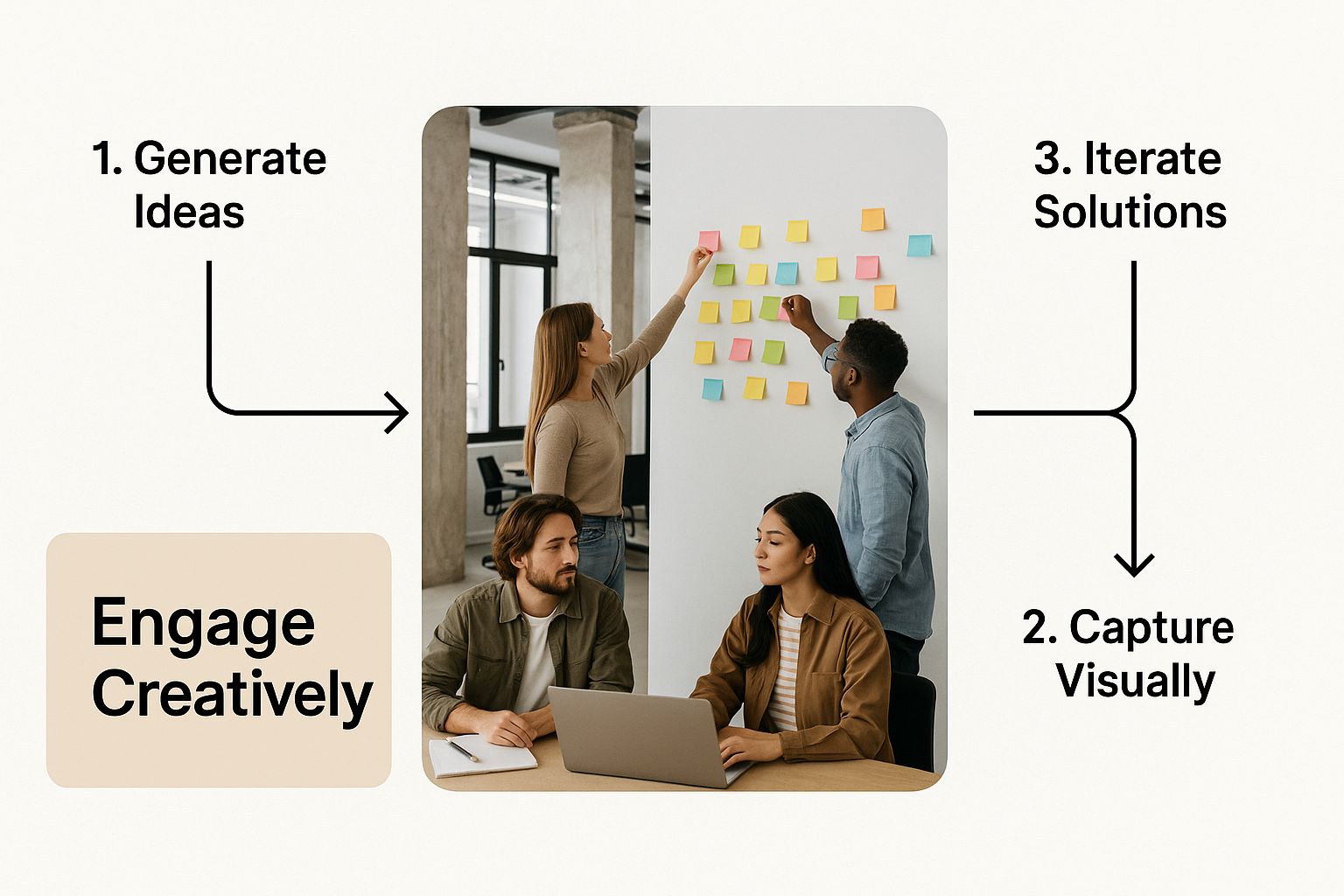
As you can see, turning one idea into many different pieces of content is a collaborative and imaginative effort.
Let’s Get Practical: Transforming One Testimonial into Three Posts
Okay, let's make this real. Say you have a fantastic customer testimonial tucked away on your website. Don’t just let it sit there! With minimal effort, you can put it to work across all your channels.
- Create a Quote Graphic: Grab the most powerful sentence from the testimonial. Slap it on a branded template with the customer's headshot (with their permission, of course). Boom. You have an instant, high-trust post for Instagram or LinkedIn.
- Film a Short Video Clip: Ask that happy customer if they'd be willing to record a quick 30-second video saying the same thing on their phone. User-generated video feels incredibly authentic and cuts through the noise far better than a polished corporate ad.
- Build a Carousel Story: Design a simple multi-slide carousel that tells their story.
- Slide 1: Start with a hook that describes the customer's initial problem.
- Slide 2: Feature the knockout quote from their testimonial.
- Slide 3: Briefly explain how your product or service solved their problem.
- Slide 4: End with a clear call to action.
Just like that, you've turned one piece of customer feedback into three distinct, high-impact social posts. Now, imagine doing that with all the assets you already have. This is how you build a powerful content engine that frees you from the daily grind.
For a deeper dive into putting this library on autopilot, check out some guides on automated social media posting. Building an evergreen system is the strategic move that guarantees your brand stays visible and valuable, even when you're busy with other priorities.
Putting Your Schedule on Autopilot with Smart Tools
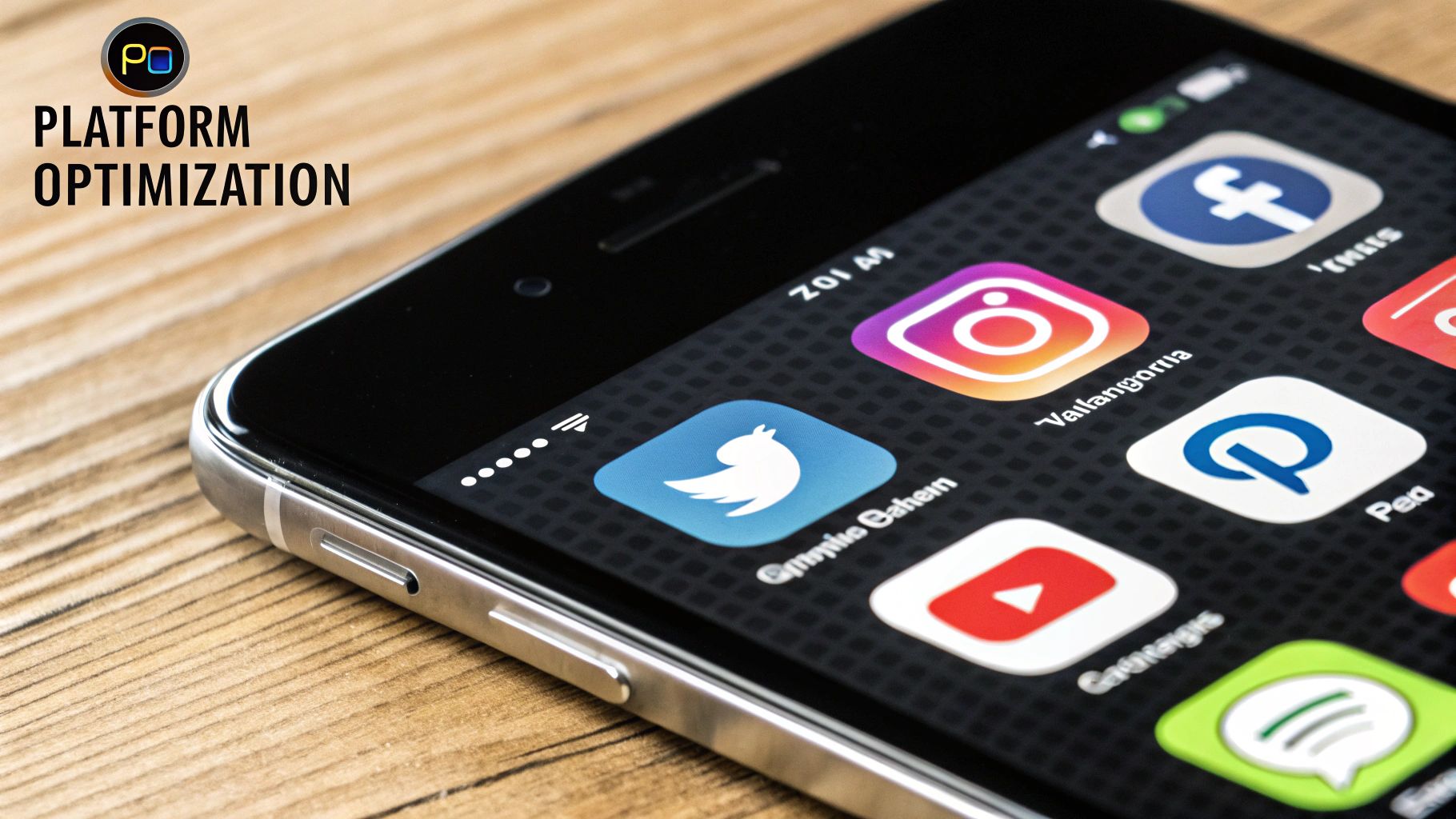
You’ve done the heavy lifting: you have a solid strategy and a library packed with fantastic evergreen content. Now, the secret to flawless execution isn't about working harder; it's about working smarter. This is where automation comes in, transforming your brilliant plans into a consistent, high-performing social media presence that doesn’t chain you to your desk.
This is the moment to bring in a dedicated tool. Platforms like EvergreenFeed are built to put your content system on autopilot, making sure your best posts are always circulating and hitting your audience at just the right time. It's not just about scheduling; it’s about creating an intelligent, self-sustaining content engine.
From Content Pillars to Automation Categories
The first practical move is to translate those content pillars you defined earlier into actual categories inside your automation tool. Think of this as the critical link in your social media content strategy—it's how you ensure every single post that goes out is perfectly aligned with your goals.
So, if your pillars are "Educational," "Behind-the-Scenes," and "Promotional," you'll simply create those same content buckets in your scheduler. This simple setup gives you precise control over the mix and frequency of your content.
You can then set up simple rules, like:
- Educational Posts: Publish three times a week on LinkedIn and Twitter.
- Behind-the-Scenes: Share twice a week, but only on Instagram Stories and Facebook.
- Promotional Content: Fire this off once on Friday across all platforms.
This gives you strategic oversight of your calendar without having to manually post every day. To see how this fits into the bigger picture, our guide on building a complete https://www.evergreenfeed.com/blog/social-media-content-calendar/ provides a great framework.
Nailing Down a Schedule That Actually Works
With your categories in place, it’s time to define a posting schedule that maximizes your reach and engagement. Firing off posts at random times is a huge missed opportunity. The key is to dive into your platform analytics to see when your audience is most active and build your schedule around their habits.
Most social media platforms have built-in analytics that show you peak activity hours. Use that data to create a custom schedule for each of your social accounts.
Your LinkedIn audience is probably most active during business hours, while your Instagram followers might be scrolling late into the evening. A one-size-fits-all schedule just doesn’t cut it anymore.
With a tool like EvergreenFeed, you can create unique schedules not just for each platform, but for each content bucket. This granular control means your most important content always goes out at the optimal time, every single time. The tool handles the rest, freeing you up for more high-impact work.
The Real Power: Content Recycling and Performance Tracking
One of the biggest wins with automation is the ability to recycle your evergreen content. A killer blog post or a glowing testimonial shouldn't just be shared once and forgotten. Automation tools can continuously pull from your content library, making sure your best assets get the repeat visibility they deserve.
This approach has a massive impact on your efficiency. It's not surprising that 58% of B2C businesses don't have a documented content strategy; the manual effort can feel overwhelming. Automation solves that problem head-on by slashing the daily workload.
Smart tools also give you the data you need. Performance tracking lets you see which posts are resonating and which are falling flat. By monitoring clicks and engagement, you can refine your library, ditching the duds and creating more of what works. It’s a feedback loop that constantly sharpens your strategy.
The principle of using technology for repetitive tasks applies elsewhere, too. Just as we advocate for streamlining social media, smart tools are also revolutionizing other time-sinks with things like automated interview scheduling. The goal is the same: let technology handle the repetition so you can focus on strategy and real human connection.
By automating your schedule, you build a consistent online presence that drives traffic, frees up hours each week, and lets you invest your time in genuine engagement—the one part of social media you can't, and shouldn't, automate.
How to Measure and Refine Your Strategy
A great social media content strategy isn’t something you set and forget. Think of it as a living, breathing plan that needs regular check-ins to stay effective. The real magic happens when you stop guessing what your audience wants and start letting the data guide you.
This means digging into your platform analytics to see what’s actually hitting the mark. It’s easy to get distracted by vanity metrics like follower counts, but the goal is to connect performance back to the content pillars you established. For instance, if you're posting educational content, are people actually sharing it? That share rate tells you far more than a simple "like." And for your promotional posts, the only number that really matters is the click-through rate (CTR).
Tracking the Right Metrics
To make your data truly useful, you have to look at the right numbers for the right content. A thousand likes on a product post is nice, but it's ultimately meaningless if nobody clicks the link to actually see the product.
Here’s a simple way I like to break it down, connecting content types to the KPIs that matter most:
- Educational Content: Keep an eye on shares and saves. These are strong signals that people find your content genuinely valuable—so much so that they want to keep it or pass it on.
- Promotional Content: Your focus here should be on click-through rates and conversion rates. This is the most direct way to measure whether your posts are successfully driving people to take action.
- Community Content: Look at comments and any user-generated content (UGC) mentions. This is how you gauge whether you're building a real conversation and fostering an engaged community.
This targeted approach gives you a crystal-clear picture of what’s working and what’s falling flat. If you want to dive even deeper, we have a complete guide on how to measure social media ROI.
The Quarterly Strategy Review
I can't stress this enough: block out time every quarter for a formal strategy review. This is your chance to step back from the day-to-day grind, look at the big picture, and make smart decisions for the next 90 days.
During this review, ask yourself some tough questions. Which content pillar sent the most traffic to our website? Did videos outperform carousel posts? What about single images? Use the answers to double down on your winners and rethink the content that isn't pulling its weight. This constant feedback loop of measuring, analyzing, and tweaking is the secret to sustainable, long-term growth.
The social media world is always in motion. Platforms like TikTok and Instagram have evolved into powerful discovery engines, making "social search" a key skill. With a staggering 94.2% of internet users active on social networks every month, simply being discoverable is half the battle. You can find more data like this in these 2025 social media statistics.
Got Questions? We’ve Got Answers.
Even the best-laid content plans can leave you with a few lingering questions. It happens to everyone. Let's tackle some of the most common ones that come up as you build out your social media strategy.
How Often Should I Actually Be Posting?
This is the million-dollar question, isn't it? But honestly, there's no single magic number. What truly matters is consistency, not just raw frequency.
Think of it this way: It’s far more effective to share three genuinely helpful, high-quality posts every week than it is to churn out seven low-effort updates just to "be active." Your audience will notice the difference.
A great starting point is to dive into your analytics. Find out when your followers are actually online and most engaged. Focus on hitting those peak times consistently, and only think about posting more once you're confident you can keep the quality high.
How Much of My Content Can Be About My Business?
It's tempting to talk about your products all the time, but that's a surefire way to lose your audience's attention. A fantastic guideline to live by is the 80/20 rule.
The idea is simple: 80% of what you post should deliver pure value. This is your chance to educate, entertain, or inspire your audience. The other 20%? That’s your window for promotional content, where you can talk directly about what you offer.
Adopting this mindset transforms your social media presence from a non-stop advertisement into a go-to resource. When you build that kind of trust, the promotional posts you do share will land with much greater impact.
I'm Stuck. Where Do I Find New Content Ideas?
Creative block is real, but your best ideas are often hiding in plain sight. You just need to know where to look.
Here are a few places I always turn to for inspiration:
- Your Customers' Questions: What are people asking in your DMs, comments, and support tickets? Every single one of those questions is a content idea waiting to happen.
- Your Competitors' Feeds: Take a look at what's working well for others in your space. The goal isn't to copy them, but to see what topics are resonating and figure out how you can offer your own unique perspective.
- Social Listening: Use tools to keep an eye on keywords and conversations happening in your industry. This is how you tap into what people are actively talking about and the problems they're trying to solve right now.
When you lean on these sources, you stop guessing what your audience wants and start creating content you know they'll find valuable.
Ready to stop the daily content grind and put your evergreen system on autopilot? EvergreenFeed automates your scheduling, so you can focus on creating content that connects. Start your free trial today and save hours every week.

